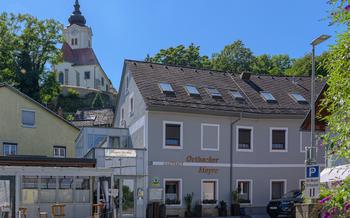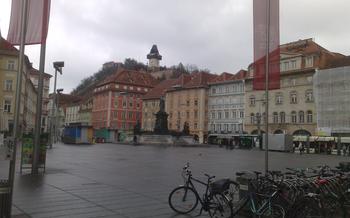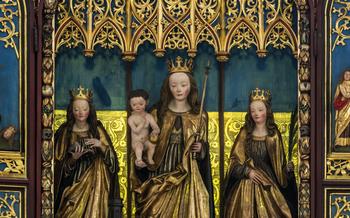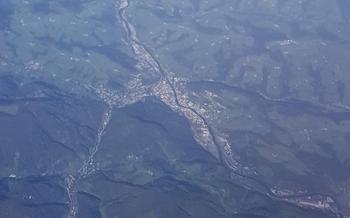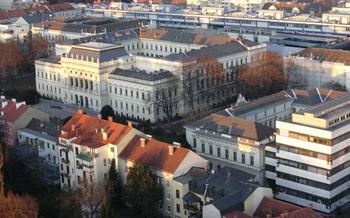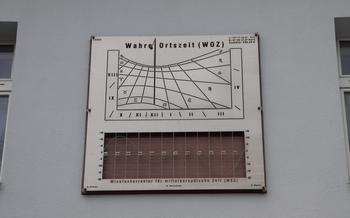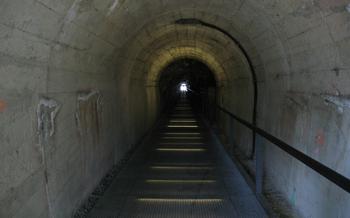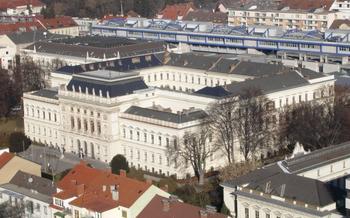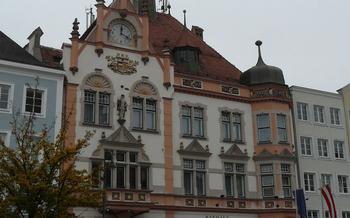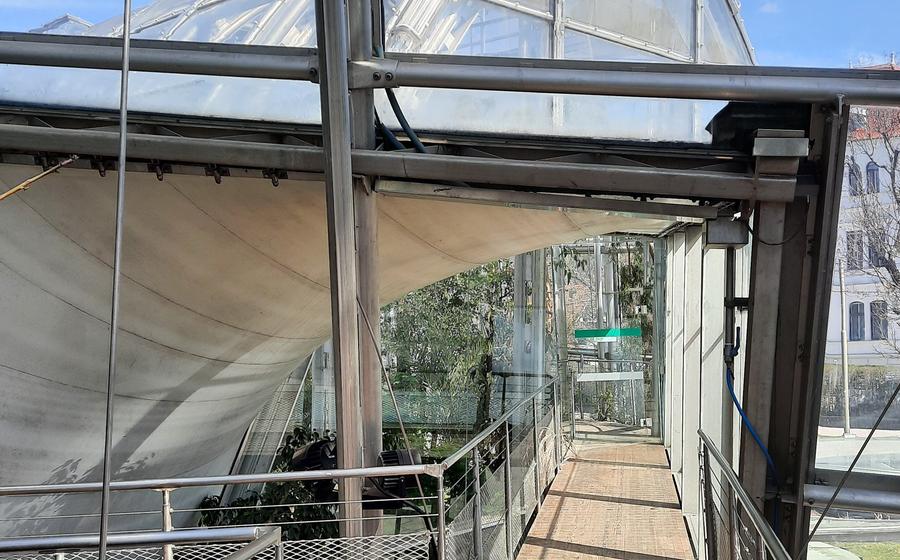
Grazer Altstadtrundgang (Historic City Walking Tour)
- Graz's Historic City Center
- Main Square
- Clock Tower
- Landhaus
- Cathedral of Graz
- Eggenberg Palace: A Baroque Masterpiece
- Kunsthaus Graz: A Bridge Between Past and Future
- Schlossberg (Castle Hill):
- Uhrturm (Clock Tower): A Symbol of Resilience
- Murinsel (Mur Island): A Floating Oasis in the City
- Joanneum Quarter: A Hub of Culture and Science
- Botanical Garden
- Farmers' Market
- Theater Graz: A Haven for Performing Arts Enthusiasts
- Insider Tip: Unveiling Graz's Hidden Gems with Guided Tours
Graz's Historic City Center
Graz's historic city center, lovingly known as the Grazer Altstadt, is a UNESCO World Heritage Site that captivates visitors with its charm and cultural heritage. Its cobbled streets, colorful buildings, and architectural masterpieces tell the story of a city that has flourished for centuries. As you wander through the old town, you'll discover a harmonious blend of medieval, Renaissance, and Baroque architecture, a testament to Graz's rich history. From the majestic Town Hall to the intricate facades of the Bürgerhäuser (town houses), every corner holds a hidden gem waiting to be explored. The city's cultural heritage seamlessly intertwines with modern life, creating a vibrant atmosphere where history and modernity coexist in perfect balance.
Main Square
Graz's Main Square, known as Hauptplatz, is the heart of the city and a vibrant hub of activity. This historic square has witnessed centuries of history and cultural events, leaving behind a rich legacy of architectural wonders. The Town Hall, with its distinctive Renaissance-style facade, dominates the square. Its intricate details and colorful coats of arms make it a captivating sight. Another notable landmark is the Plague Column, a poignant reminder of the city's resilience during times of adversity. Street performers, outdoor cafes, and lively markets contribute to the square's vibrant atmosphere, inviting visitors to soak in the city's energy and charm.
Clock Tower
Graz's Clock Tower, known as the Uhrturm, stands as a proud symbol of the city's rich history and architectural heritage. With its distinctive Renaissance style, the tower has become an iconic landmark that attracts visitors from around the world. Built in the 13th century, the Uhrturm initially served as a watchtower and a prison.
Over the centuries, it underwent several modifications and additions, resulting in the impressive structure we see today. The tower boasts an intricate astronomical clock, crafted by master craftsmen in the 16th century. This remarkable timepiece not only displays the time but also features moving figures that depict the phases of the moon and the zodiac signs, offering a glimpse into the intricate mechanics of the past.
Ascend the winding staircase to reach the observation deck atop the Uhrturm and be rewarded with breathtaking panoramic views of Graz. From this vantage point, you can admire the city's red-tiled rooftops, the winding Mur River, and the distant hills that surround the city. The Doppeladler, the double-headed eagle that sits atop the tower, symbolizes the city's strong connection to the Holy Roman Empire.
Landhaus
Built in the 16th century, the Landhaus is a magnificent Renaissance palace that serves as the seat of the Styrian Parliament. Its elaborate inner courtyard features arcaded galleries and a stunning fountain, creating a harmonious blend of architectural styles. Admire the intricate carvings and decorative elements that adorn the facade, showcasing the artistry and craftsmanship of the era. The Landhaus also hosts art exhibitions and cultural events throughout the year, offering visitors the chance to delve deeper into Graz's rich cultural heritage.
Cathedral of Graz
The Grazer Dom (Graz Cathedral) stands as a testament to the city's rich religious heritage and architectural prowess. Constructed over several centuries, it seamlessly blends Gothic and Romanesque elements, captivating visitors with its intricate details and imposing grandeur. The cathedral's exterior boasts stunning stained glass windows, intricate carvings, and a towering spire that pierces the sky.
Step inside, and you'll be awed by the cathedral's ornate interior, adorned with elaborate frescoes, opulent altars, and a breathtaking vaulted ceiling. The centerpiece of the cathedral is undoubtedly the elaborate mausoleum of Emperor Ferdinand II, an impressive work of art that serves as a reminder of the Habsburg dynasty's deep connection to Graz.
Beyond its religious significance, the Graz Cathedral holds a special place in the hearts of locals and visitors alike. It's a place of worship, a repository of history, and a symbol of the city's enduring spirit. Whether you're a history buff, an architecture enthusiast, or simply seeking a moment of tranquility, the Graz Cathedral is an absolute must-see.
Eggenberg Palace: A Baroque Masterpiece
Nestled on the outskirts of Graz, Eggenberg Palace stands as a testament to the grandeur of the Baroque era. Built in the 17th century by Prince Hans Ulrich von Eggenberg, this magnificent palace boasts elaborate architecture, sprawling gardens, and a rich history.
Its facade is adorned with intricate carvings, sculptures, and decorative elements, showcasing the intricate craftsmanship of the era. Inside, visitors are greeted by a series of opulent rooms, each adorned with lavish furnishings, paintings, and tapestries. The palace's highlight is its grand ballroom, which features a stunning ceiling fresco depicting the four continents.
Surrounding the palace is a breathtaking park, an oasis of tranquility within the city. Wander through its manicured gardens, admire the ornate sculptures, and explore the hidden paths that lead to secluded corners. Take a moment to savor the beauty of the park's flora, from the vibrant colors of the flower beds to the towering trees that provide shade and serenity.
Today, Eggenberg Palace serves as a UNESCO World Heritage Site and houses the Universalmuseum Joanneum, a regional museum that showcases a diverse collection of exhibits. From ancient artifacts to contemporary art, the museum offers a glimpse into the rich cultural heritage of Styria and beyond.
Kunsthaus Graz: A Bridge Between Past and Future
Nestled along the picturesque banks of the Mur River, the Kunsthaus Graz, a captivating contemporary art museum, stands as a testament to Graz's embrace of modern architecture and its vibrant art scene. With its unique design resembling a "friendly alien" or a "spaceship," the Kunsthaus Graz has become a striking icon of the city's skyline.
Completed in 2003, the Kunsthaus Graz was designed by renowned British architects Peter Cook and Colin Fournier. Its bold and unconventional form, featuring an organic glass-and-steel facade, has garnered widespread acclaim and positioned Graz as a significant hub for contemporary art.
Inside the Kunsthaus Graz, visitors are treated to a diverse array of contemporary art exhibitions, installations, and performances. The museum's collection features works by both established and emerging artists from around the world, pushing the boundaries of artistic expression and challenging traditional notions of art.
The Kunsthaus Graz is not just a museum; it is also a vibrant cultural center that hosts a variety of events, including concerts, film screenings, and lectures. The museum's rooftop terrace offers panoramic views of Graz, blending the city's rich history with its modern architectural marvels.
Whether you are an art enthusiast or simply seeking an alternative perspective on Graz, the Kunsthaus Graz is a must-visit destination. This architectural masterpiece not only houses world-class contemporary art but also serves as a symbol of Graz's transformation into a dynamic and forward-thinking city.
Schlossberg (Castle Hill):
Graz's most iconic landmark, Schlossberg (Castle Hill), dominates the city's skyline and offers breathtaking panoramic views. Atop the hill stands the Uhrturm (Clock Tower), Graz's most recognizable symbol. Take the Schlossbergbahn funicular, built in 1894, for a scenic ride to the summit or embark on a leisurely walk through its verdant slopes, passing by the remnants of the medieval fortifications. Immerse yourself in history as you explore the remnants of the hilltop fortress, once a vital part of Graz's defense system. Marvel at the stunning views of the city, the winding Mur River, and the surrounding countryside from the observation deck. The Schlossberg is also home to the Kasematten, a network of underground tunnels and chambers that once served as air raid shelters during World War II and are now open to the public.
Uhrturm (Clock Tower): A Symbol of Resilience
The Uhrturm, or Clock Tower, stands tall and proud as a symbol of Graz's resilience. Built in the 13th century, this iconic landmark has witnessed the city's transformation over the years. Its sturdy structure, adorned with intricate carvings and sculptures, tells tales of the city's rich history.
One of the most striking features of the Uhrturm is the Doppeladler, or Double Eagle, that perches atop the tower. This majestic symbol of the Austrian Empire represents strength, power, and the enduring spirit of the city. Its wings outstretched, the eagle seems to embrace the entire city, watching over its people and safeguarding their stories.
Ascending the tower's spiral staircase is a journey through time. The walls whisper stories of the watchmen who once kept vigil over the city, their eyes scanning the horizon for signs of danger. The tower's clock, with its intricate mechanism, has ticked away the hours, marking the passage of time and the unfolding of countless lives.
From the observation deck at the top of the Uhrturm, visitors are rewarded with breathtaking panoramic views. The city stretches out before them, a tapestry of red-roofed buildings, winding cobblestone streets, and lush green parks. The Mur River glistens in the sunlight, reflecting the vibrant energy of the city.
The Uhrturm stands as a testament to Graz's indomitable spirit, its ability to rise above adversity and emerge stronger. It is a symbol of the city's rich heritage, its cultural identity, and its enduring charm.
Murinsel (Mur Island): A Floating Oasis in the City
Amidst the vibrant streets of Graz, the Murinsel, or Mur Island, emerges as a symbol of architectural innovation and urban ingenuity. Situated in the heart of the city, this floating island rests gracefully on the gentle currents of the Mur River, inviting visitors to explore its unique blend of art, culture, and nature.
Designed by the renowned Austrian artist and architect Vito Acconci, the Murinsel seamlessly integrates into the picturesque cityscape. Its striking silhouette, resembling a giant seashell or a futuristic spaceship, has become an iconic landmark of Graz. The island's sleek, organic form complements the historical architecture of the surrounding buildings, creating a harmonious dialogue between past and present.
Spanning over 50 meters in length, the Murinsel offers a diverse range of attractions. Visitors can stroll along the island's promenade, taking in the panoramic views of the river and the city. A stage at the center of the island hosts cultural events, concerts, and performances throughout the year, providing a vibrant backdrop to the tranquil river setting.
Families with children will delight in the Murinsel's spacious playground, equipped with slides, swings, and climbing structures. The island also features a charming cafe where visitors can relax and enjoy refreshments while soaking in the serene atmosphere.
The Murinsel is more than just a floating platform; it represents Graz's commitment to sustainable urban development. The island's design incorporates eco-friendly features such as solar panels and a rainwater collection system, showcasing the city's dedication to environmental responsibility.
Whether you're seeking a tranquil retreat, a cultural experience, or a fun family outing, the Murinsel offers something for everyone. This unique urban oasis invites visitors to immerse themselves in the beauty, creativity, and sustainability that define the city of Graz.
Joanneum Quarter: A Hub of Culture and Science
In the heart of Graz, nestled between the Mur River and the Schlossberg, lies the Joanneum Quarter. This vibrant district is a testament to the city's rich cultural and scientific heritage, boasting an array of museums, libraries, and research institutions.
The Joanneum Universalmuseum, the crown jewel of the quarter, houses a vast collection of artifacts spanning natural history, art, and cultural history. Explore the wonders of the natural world in the museum's extensive displays, marvel at the masterpieces of old masters in the art gallery, and delve into the fascinating history of Styria in the cultural history section.
The Graz Art Museum, another prominent institution in the Joanneum Quarter, showcases a diverse collection of contemporary and modern art. From thought-provoking installations to captivating paintings, the museum offers a platform for local and international artists to showcase their work.
Beyond museums, the Joanneum Quarter is home to several libraries and research institutions, creating a vibrant intellectual atmosphere. The University of Graz Library, with its impressive collection of books and manuscripts, is a haven for scholars and students alike.
Strolling through the Joanneum Quarter, visitors can admire the beautiful architecture that reflects the city's rich history. Baroque facades, Renaissance courtyards, and modern structures blend harmoniously, creating a visually captivating cityscape.
Whether you're an art enthusiast, a history buff, or simply seeking intellectual stimulation, the Joanneum Quarter is a must-visit destination in Graz. Immerse yourself in the world of culture and science as you explore this vibrant district, where knowledge and creativity intertwine.
Botanical Garden
The Botanischer Garten Graz, established in 1811, is a botanical garden and research facility located just a short walk from the city center. With over 10,000 species of plants from around the world, the garden offers a diverse array of flora, including rare and endangered species. Visitors can explore the various sections of the garden, each showcasing a unique collection of plants. From the Alpine Garden, featuring hardy plants adapted to high-altitude environments, to the Tropical House, with its lush tropical plants and exotic flowers, the Botanical Garden offers a journey through diverse ecosystems.
A highlight of the garden is the Rose Garden, home to over 700 varieties of roses. The vibrant blooms and heady fragrances create a captivating display of colors and scents. Visitors can also admire the Systematic Garden, where plants are arranged according to their scientific classification, providing an educational and informative experience.
Beyond its botanical significance, the garden is also a popular destination for relaxation and recreation. Visitors can stroll along the winding paths, enjoy a picnic on the manicured lawns, or simply soak in the tranquil atmosphere surrounded by nature. The garden is a haven of peace and serenity within the bustling city, offering a respite from the daily grind.
Farmers' Market
The farmers' market in Graz is a vibrant hub of local culture and a great place to experience the city's culinary delights. Held every Saturday morning in the picturesque Hauptplatz, the market attracts locals and visitors alike with its colorful stalls and fresh produce.
Strolling through the market, you'll find an array of local vendors selling fresh fruits and vegetables, meats, cheeses, and other regional specialties. The air is filled with the aromas of freshly baked bread, roasted coffee, and traditional Austrian pastries.
At the market, you can buy everything from seasonal fruits and vegetables to locally produced honey, jams, and juices. You can also find a variety of handmade crafts, such as pottery, textiles, and jewelry.
The farmers' market is more than just a place to shop. It's also a great place to meet locals, learn about traditional Austrian cuisine, and sample some of the region's specialties. Many vendors offer free samples of their products, so you can taste before you buy.
Whether you're looking for fresh ingredients to cook a delicious meal or simply want to soak up the local atmosphere, the farmers' market in Graz is a must-visit.
Insider Tip:
Arrive early to get the best selection of produce. The market starts at 6 am and is busiest between 8 am and 10 am.
Theater Graz: A Haven for Performing Arts Enthusiasts
Theater Graz stands as a majestic cultural beacon within the city's vibrant heart, captivating audiences with its diverse repertoire of world-class performances. Whether you're an opera aficionado, a ballet enthusiast, or a theater buff, this renowned venue promises an unforgettable experience.
Since its inception in the 18th century, Theater Graz has played a pivotal role in shaping the city's cultural landscape. Its elegant facade and opulent interior exude a timeless charm, providing a fitting backdrop for the artistic wonders that unfold within.
Step inside the theater's grand auditorium and let the magic envelop you. The plush seating and impeccable acoustics create an intimate setting that fosters a profound connection between performers and spectators. As the curtains rise, immerse yourself in the captivating world of opera, where soaring melodies and dramatic arias transport you to realms of passion, tragedy, and triumph.
Beyond opera, Theater Graz showcases an eclectic array of ballet performances, featuring graceful dancers who defy gravity with their breathtaking leaps and spins. The theater's ballet company has garnered international acclaim for its virtuosity and artistic excellence, delivering performances that are both visually stunning and emotionally resonant.
For those who prefer the spoken word, Theater Graz offers a diverse range of plays, from contemporary dramas to classic comedies. Talented actors bring these works to life with their powerful performances, delving into the complexities of the human condition and exploring universal themes that resonate with audiences of all backgrounds.
Whether you're a seasoned theatergoer or a newcomer to the performing arts, Theater Graz promises an unforgettable evening of entertainment and cultural enrichment. Its rich history, stunning architecture, and world-class performances make it a must-visit destination for anyone seeking a truly immersive theatrical experience.
Insider Tip: Unveiling Graz's Hidden Gems with Guided Tours
To delve deeper into the rich tapestry of Graz's storied past, consider joining a guided tour of the Grazer Altstadtrundgang. These tours, led by knowledgeable local guides, provide an immersive experience that brings the city's history and landmarks to life. As you stroll through the narrow cobblestone streets, your guide will regale you with tales of the city's founding, its rise to prominence as a cultural and economic hub, and the fascinating characters who have shaped its destiny. You'll gain insights into the architectural styles, historical events, and cultural traditions that have made Graz the vibrant and captivating city it is today. Whether you're a history buff, an architecture enthusiast, or simply someone who loves to explore new places, a guided tour of the Grazer Altstadtrundgang is an experience you won't want to miss.
